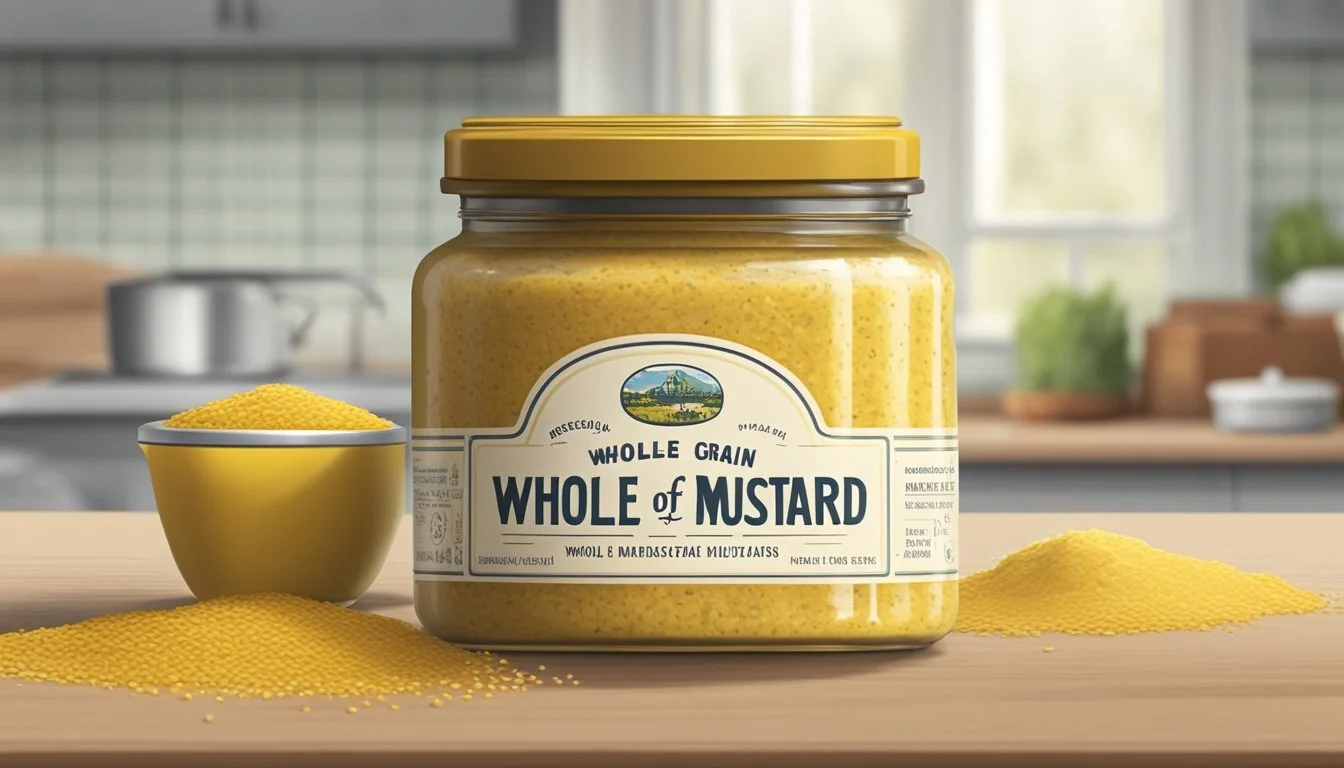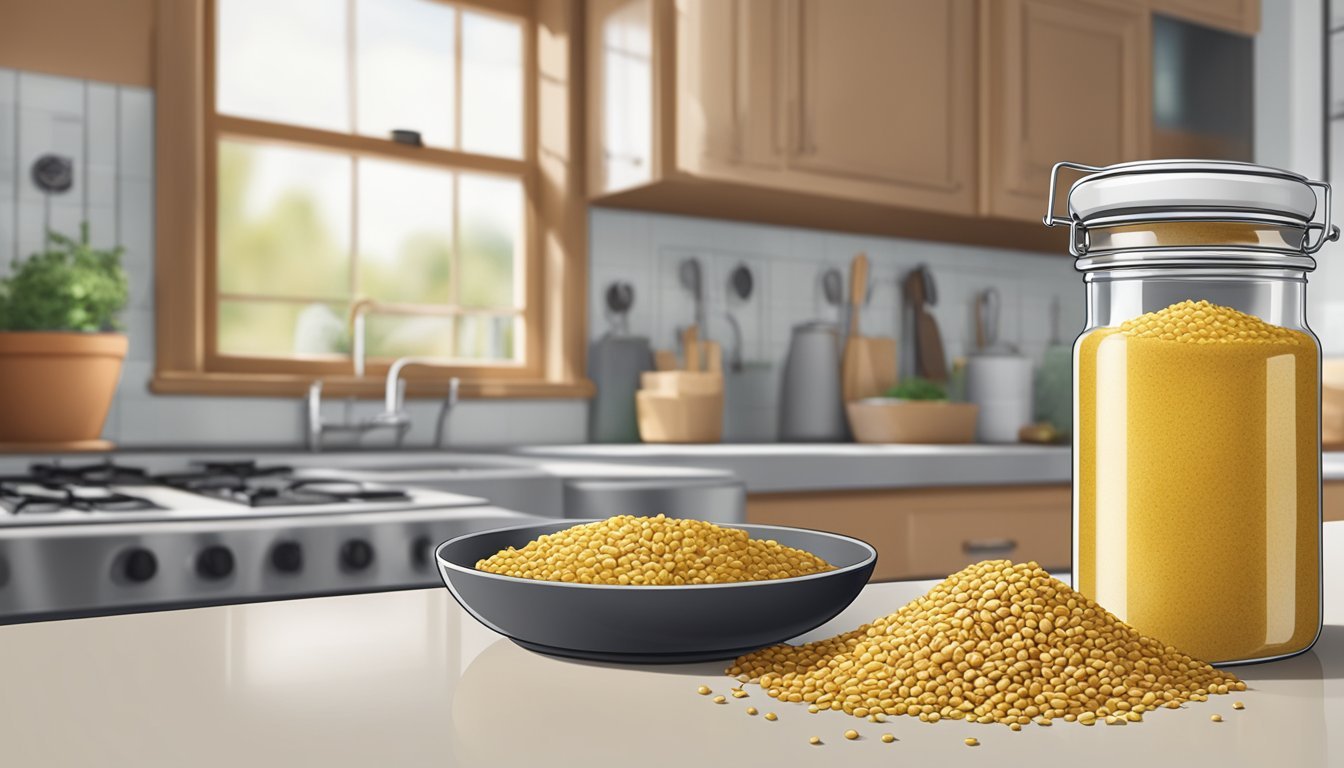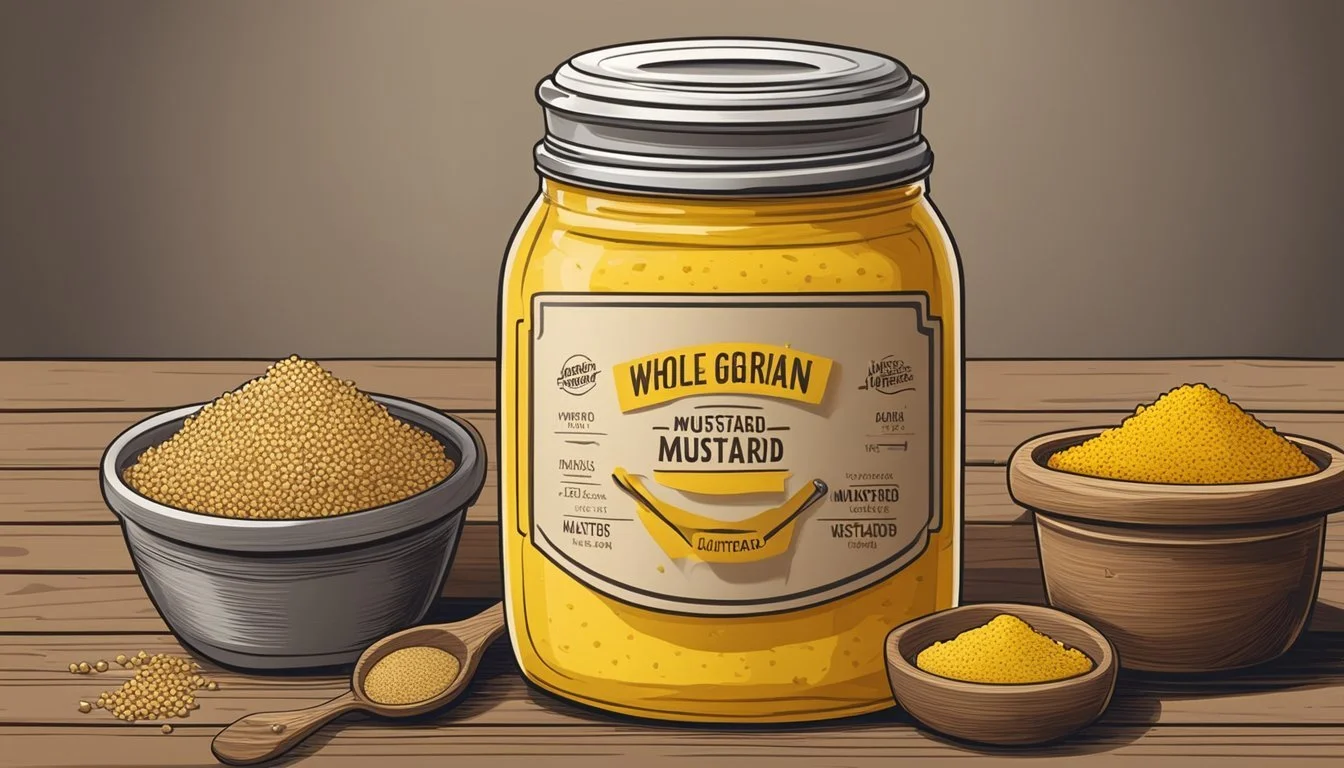How Long Does Whole Grain Mustard Last?
Shelf Life and Storage Tips
Whole grain mustard (how long does whole grain mustard last?) is recognized for its bold flavor and grainy texture, making it a favorite among cooking enthusiasts and mustard aficionados. Its distinctive quality is derived from the partially ground mustard seeds which not only add to the condiment's robust taste but also contribute to its longer shelf life compared to other more processed mustard varieties. When discussing the longevity of whole grain mustard, it is essential to take into account the conditions under which it is stored.
Once opened, whole grain mustard typically maintains optimal quality for up to two months when stored in the refrigerator. This extended shelf life can be attributed to the acidity and natural preservatives found within the mustard which are known for their preserving qualities. The cool and stable temperature of a fridge helps in slowing down the degradation process that can affect the mustard's quality. However, if the mustard is kept continuously refrigerated and tightly sealed, this period may extend up to a year while still preserving its desired taste and texture.
The key to ensuring whole grain mustard remains at its best is proper storage. Keeping it in an airtight container, away from light, and at a consistent, cool temperature will greatly mitigate the loss of flavor and prevent spoilage. As with many condiments, the shelf life of whole grain mustard also hinges on its exposure to contaminants – each dip of a potentially unclean utensil can introduce bacteria that may compromise the mustard's integrity. Therefore, maintaining cleanliness can also play a role in prolonging the freshness and edibility of whole grain mustard.
Understanding Mustard Varieties
When exploring the world of mustards, one will discover a diverse spectrum ranging from the mildly tangy to the piquantly hot, each with unique characteristics suitable for various culinary needs.
Types of Mustard
Whole Grain Mustard: This variety is known for its visibly whole, or partially whole mustard seeds, offering a robust texture and pungent flavor.
Dijon Mustard: Originating from Dijon, France, this mustard is smooth with a sharp and strong taste, made from brown or black mustard seeds mixed with white wine or wine vinegar.
Honey Mustard: A sweet and tangy blend, honey mustard combines the flavors of mustard with the natural sweetness of honey, creating a milder condiment popular in dressings and dips.
Yellow Mustard: Often referred to as American mustard, this bright yellow condiment is mild, made with white mustard seeds and turmeric.
Chinese Mustard: Known for its intense heat, Chinese mustard is made from mustard seeds that have not been toned down by the addition of acids.
Spicy Brown Mustard: A spicier alternative with a coarser grind than yellow mustard, often incorporating a mix of brown mustard seeds and spices.
Horseradish Mustards: These are zesty varieties that incorporate the heat of horseradish, often used in deli sandwiches to add a sharp, peppery note.
Comparing Whole Grain Mustard to Others
Texture: Whole grain mustard stands out for its coarse, rustic texture due to partially crushed, intact mustard seeds.
Taste: In terms of flavor, it brings a more intense and less processed taste compared to smoother varieties like Dijon mustard, which has a creamier consistency and a sharper, more pronounced tanginess.
Usage in Cuisine: While whole grain mustard is lauded for its visual appeal and provides a bold burst of flavor in dressings and marinades, Dijon is preferred for smoother sauces and as an emulsifying agent. Yellow mustard is commonly used as a classic topping for hot dogs and sandwiches, honey mustard is a favored choice for a sweet and mild dressing, and horseradish mustards offer a hot, pungent flavor that pairs well with red meats.
Each type of mustard caters to different culinary applications, and understanding the properties of whole grain mustard relative to its counterparts is key to optimizing its use in cooking.
Shelf Life Basics
When it comes to whole grain mustard, understanding the shelf life is essential for maintaining its flavor and quality.
Factors Affecting Shelf Life
Shelf life is influenced by several factors. Storage conditions play a pivotal role: unopened whole grain mustard is typically best kept in a cool, dry place like a pantry. Once opened, refrigeration is necessary to extend its freshness. Temperature fluctuations and exposure to light can degrade the mustard's quality. Packaging is also key—the integrity of the seal can prevent the entry of contaminants that might accelerate spoilage.
Expiration and Best By Dates
Best by dates are indicators of quality, not safety. They inform consumers when the product is expected to be at its peak flavor. For whole grain mustard, the best by date usually reflects a period when it will be at its best quality. After this date, while it might not be at its prime, it doesn't necessarily mean the mustard is harmful to consume if it has been stored properly. It’s important to note that an expiration date differs from a best by or best before date, as it relates to when the food should no longer be consumed.
Storing Mustard for Optimal Freshness
To maintain the quality and freshness of whole grain mustard, proper storage is critical. This section discusses the best storage methods and the impact of storage conditions on the mustard's quality.
Refrigeration versus Pantry
Refrigeration is necessary once whole grain mustard is opened. It should be kept in a cool, dark place within the refrigerator to retain its flavor and prevent spoilage. An opened jar of whole grain mustard can last in the refrigerator for up to 12-18 months when stored properly.
On the other hand, unopened whole grain mustard can be stored in the pantry. The ideal pantry storage conditions are a cool, dry place, away from heat and light sources. If these conditions are met, an unopened bottle or jar of mustard can remain shelf-stable for up to two years.
Effect of Storage Conditions on Quality
The quality of whole grain mustard is directly affected by storage conditions. Whether in the pantry or the refrigerator, mustard should be stored in an airtight container to avoid exposure to external elements.
Storage Location Opened Mustard Unopened Mustard Pantry 1-2 months Up to 2 years Refrigerator 12-18 months Not Applicable
A cool and dark environment slows down the degradation process, preserving both the freshness and flavor profile of the mustard. When stored in the refrigerator after opening, ensure that the cap is tightly sealed after each use to extend the mustard's shelf life and maintain its quality.
Signs of Spoilage and Food Safety
Recognizing the signs of spoilage is crucial for maintaining food safety. Whole grain mustard can go bad, and consumers need to be aware of how to detect signs of spoilage to prevent foodborne illnesses.
Visual and Textural Changes
Spoiled mustard often exhibits noticeable visual changes. Consumers should look for:
Color: A dull, faded, or brownish hue replacing the bright, vibrant color.
Mold: Any presence of mold indicates spoilage, and the mustard should not be consumed.
Separation: While some separation of ingredients is normal, excessive separation can indicate degradation.
However, it's essential to note that some textural changes may occur without the mustard necessarily being bad. The emulsion might break down over time, especially beyond the best-by date.
Smell and Taste Alterations
The sensory qualities of mustard – particularly its smell and taste – can also signal spoilage:
Smell: An off or sour smell different from the mustard's tangy, sharp aroma is a telltale sign.
Taste: Any noticeable deviation from the original mustard flavor, particularly an excessively bitter, sour, or otherwise off taste, should be considered a warning.
For safety reasons, if the mustard exhibits any altered smell or taste, it should be discarded.
Maximizing Mustard Quality and Flavor
The longevity of whole grain mustard in both taste and quality can be significantly affected by the right storage and usage practices. This ensures the mustard's pungent flavor is preserved, making it a delicious addition to sandwiches, sauces, and onion rings.
Preservation Techniques
Storage Location and Conditions:
Whole grain mustard should be kept in a cool, dark place before opening. Once opened, it should be stored in the refrigerator tightly covered at all times. Ideal storage temperatures are between 50°F (10°C) and 70°F (21°C). The best quality can be expected for 12-18 months when refrigerated properly.
Containers: Use opaque containers to shield the mustard from light, which can degrade its quality.
Shelf Life: In the pantry:
Opened mustard typically lasts 1-2 months.
In the refrigerator:
Opened mustard can retain best flavor for 12-18 months.
Using Mustard in Cooking
Incorporating Mustard for Flavor Enhancement:
As an ingredient, whole grain mustard brings a robust, pungent flavor to dishes. It can be an essential component for enhancing the taste of various recipes such as glazes, dressings, and marinades.
To maintain the quality and flavor of mustard in cooking, integrate it into the dish according to recipe instructions, ensuring that the ingredients complement each other.
Best Practices:
Add mustard to sandwiches or sauces for a flavorful punch.
Use unsparingly with onion rings either as a condiment or incorporated into the batter for a bold taste.
Tips for Homemade Mustard Preparation
Preparing homemade mustard involves careful selection of quality ingredients and proper storage to ensure freshness and flavor. These tips will help one craft a mustard that's both delicious and long-lasting.
Ingredient Selection and Handling
Mustard Seeds: One should select high-quality mustard seeds for their homemade mustard. Typically, a combination of brown mustard seeds and yellow mustard seeds (how long do yellow mustard seeds last?) is used for a balanced flavor. Brown seeds contribute a fiery punch, while yellow seeds add a milder taste.
Brown Mustard Seeds: These are the smaller and spicier of the two, ideal for those who prefer a robust mustard.
Yellow Mustard Seeds: Larger and less pungent, offering a classic mustard flavor that's friendlier on the palate.
Vinegar and Water: Vinegar is essential for both flavor and preservation.
Vinegar: Acts as a natural preservative. Options include apple cider, white wine, or even stout vinegar for a distinct twist.
Water: Typically combined with vinegar to adjust intensity. One can experiment with the ratio according to taste.
Additional Ingredients: Depending on the desired flavor profile, one can add salt and sugar to taste, and consider a variety of spices such as turmeric for a traditional yellow mustard or thyme for an aromatic variant.
It's imperative that all utensils and containers used are clean to prevent contamination, ensuring the longevity of the homemade mustard.
Storage Recommendations
Ideal Conditions: Homemade mustard should be stored in airtight containers to prevent exposure to air, which can degrade its quality. Store these containers in a cool, dark place such as a pantry or a refrigerator.
Refrigeration: Extends the freshness of the mustard and maintains its pungency for a longer period.
No Heat or Light Exposure: Heat and light can break down the mustard, leading to loss of flavor and potential spoilage.
Monitoring Freshness: Over time, homemade mustard may lose its potency. It generally stays fresh for several months, but one should always check for any off-smells or discoloration before use.
By following these focused guidelines in ingredient selection and storage, one can ensure that their homemade mustard remains flavorful and usable for as long as possible.
Extended Shelf Life Practices
Prolonging the shelf life of whole grain mustard involves proper storage techniques and understanding when to discard the condiment to ensure safety and quality.
Avoiding Contaminants
Whole grain mustard's longevity is notably affected by how it's handled. To avoid introducing contaminants that can accelerate spoilage:
Use clean utensils every time to prevent the introduction of bacteria.
Do not directly dip foods in the jar.
Close the lid tightly after each use to limit exposure to air and moisture.
When to Discard
There are definitive signs when whole grain mustard should be discarded:
Odor: If the mustard develops an off smell, it may indicate spoilage.
Appearance: Any signs of mold growth or noticeable changes in texture warrant disposal.
Taste: Mustard that has significantly deteriorated in flavor may no longer be enjoyable, though not necessarily unsafe.
By following these practices, one can ensure their mustard remains a usable and enjoyable condiment for the longest time possible.
Handling Unopened Mustard
When one purchases whole grain mustard, its shelf life in an unopened state is a crucial point of consideration. Proper storage conditions significantly impact the longevity and quality of the mustard, ensuring that it remains suitable for use.
Sealed Container Longevity
Unopened whole grain mustard typically has a long shelf life due to the natural preservatives in the ingredients, and it remains fresh longer when it is not exposed to detrimental external factors. A sealed container of whole grain mustard can last for up to two to three years when stored correctly.
Key factors to ensure optimal longevity include:
Type: Whole grain mustard has a substantial shelf life, thanks to the acidity and preservatives present in the condiment's makeup.
Storage Location: A cool, dry area away from direct sunlight or heat sources is ideal to prevent the degradation of quality.
Preservation: The integrity of the mustard is preserved effectively when the seal of the container remains unbroken.
Shelf Life of Mustard: An opened container of mustard generally has a shorter shelf life compared to unopened mustard due to exposure to air and contaminants.
By keeping the unopened mustard in optimal conditions, one can expect to maintain its best quality for consumption for a considerable period, well beyond its best-by date.
Comparative Storage of Mustard Varieties
When it comes to mustard, including whole grain, Dijon, and honey varieties, storage conditions significantly influence shelf life. Both refrigerated and pantry environments offer distinct preservation benefits.
Refrigerated vs. Pantry Shelf Life of Different Mustard Types
Whole Grain Mustard:
Pantry: Typically maintains quality for up to 1 year unopened.
Refrigerated: Once opened, can last for 12-18 months, retaining optimal flavor.
Dijon Mustard:
Pantry: Unopened, Dijon mustard can last smoothly for 2-3 years.
Refrigerated: After opening, it is best kept in the fridge and used within 12-18 months for best taste.
Honey Mustard:
Pantry: Unopened, it stays fresh for up to 2 years due to its sugar content.
Refrigerated: Opened honey mustard should be refrigerated and ideally used within 1 year.
The shelf life of mustard varieties like Dijon and honey can be compared to other condiments such as ketchup and mayonnaise, which also have extended shelf lives when stored properly; ketchup can last 6-12 months refrigerated after opening, while mayonnaise, due to its ingredients, should be used within 2-3 months after opening and always refrigerated.
Mustard Alternatives and Mixtures
When whole grain mustard is not available, one can create alternative mixtures that mimic its distinct flavor and texture by combining other condiments. This section provides insights into how one might blend various ingredients to substitute whole grain mustard in a recipe.
Mixing Mustard with Other Condiments
Honey: Adding honey to prepared mustard can introduce a touch of sweetness, akin to the subtle sweetness found in whole grain mustard. Here's a simple blending ratio to consider:
Prepared Mustard Honey 1 tbsp 1 tsp
Vinegar: To replicate the tanginess of whole grain mustard, incorporating vinegar into spicy brown mustard or ground mustard can be effective. Adjust the amount of vinegar to taste, starting with small amounts to prevent overpowering the mixture.
Ketchup: For a milder flavor and added viscosity, ketchup can be mixed with prepared mustard. The tomato base can somewhat dilute the pungency, resulting in a smoother condiment.
Mayonnaise: Create a creamy mustard mixture by combining mayonnaise with ground mustard. This can yield a spread with a similar texture to whole grain mustard but with a milder flavor profile.
Horseradish: To introduce a more intense heat and complexity to a mustard mixture, one might add a small quantity of horseradish. This works especially well with spicy brown mustard to approximate the robust taste of whole grain mustard.
The suggested mixtures focus on achieving a balance of flavor and texture that resembles whole grain mustard. It should be noted that while these mixtures can serve as a substitute, the unique character of whole grain mustard, with its visible mustard seeds and particular taste, cannot be entirely replicated.










